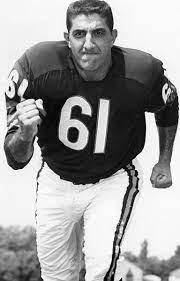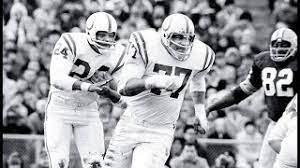Goldstein, Richard (September 12, 2024). "Joe Schmidt, Who Elevated the Middle Linebacker's Role, Dies at 92". The New York Times. Retrieved September 12, 2024.
"Joe Schmidt Stats". Pro-Football-Reference.com. Sports Reference LLC. Retrieved October 12, 2016.
Jim Sargent (1995). "Joe Schmidt: Detroit's Lion Behind the Line" (PDF). The Coffin Corner, Vol. 17, No. 6. Pro Football Researchers. pp. 1–6.
"Pittsburgh Panthers School History". SR/College Football. Sports Reference LLC. Retrieved October 13, 2016.
"1952 Pittsburgh Panthers Schedule and Results". SR/College Football. Sports Reference LLC. Retrieved October 13, 2016.
"Joe Schmidt". College Football Hall of Fame. Football Foundation. Retrieved October 13, 2016.
"Pitt Football Retired Jersey: Joe Schmidt". University of Pittsburgh. Archived from the original on October 14, 2016. Retrieved October 13, 2016.
International News Service, "Hardeman, Morehead on INS All-American team[permanent dead link]," Rome News-Tribune, p. 15 (November 30, 1952). Retrieved March 21, 2010.
"Joe Schmidt, Pitt Star, In Senior Bowl". Pittsburgh Post-Gazette. December 16, 1952. p. 21 – via Newspapers.com. Open access icon
Jack Saylor (July 26, 1973). "How Schmidt Rose to Top". Detroit Free Press. pp. 1D, 3D – via Newspapers.com. Open access icon
Bob Latshaw (September 28, 1953). "Lions Bowl Over Steelers in Opener, 38–21: Walker and Layne Pave Victory Path". Detroit Free Press. pp. 31, 33 – via Newspapers.com. Open access icon
"Pittsburgh Steelers 21 at Detroit Lions 38 Sunday, September 27, 1953". Pro-Football-Reference.com. Sports Reference LLC. Retrieved February 1, 2016.
"1953 Detroit Lions Statistics & Players". Pro-Football-Reference.com. Sports Reference LLC. Retrieved October 15, 2016.
"1954 Detroit Lions Statistics & Players". Pro-Football-Reference.com. Sports Reference LLC. Retrieved October 15, 2016.
"Cleveland Gets Even With Lions". Detroit Free Press. p. 24 – via Newspapers.com. Open access icon
"Otto Graham Heads AP All-Pro Team: Detroit Cops More Spots Than Cleveland Champs". The Shreveport (LA) Times. December 30, 1954. p. 11A – via Newspapers.com. Open access icon
"Six Lions Win Spots on UP Pro Team". Detroit Free Press. December 19, 1954. p. 2C – via Newspapers.com. Open access icon
"Six Lions Get Pro Bowl Posts". Detroit Free Press. December 16, 1954. p. 30 – via Newspapers.com. Open access icon
"NFL Single-Season Fumbles Recovered Leaders". Pro-Football-Reference.com. Sports Reference LLC. Retrieved October 15, 2016.
"Lions Coach Retained". The Detroit Reporter. December 12, 1955. p. 7 – via Newspapers.com. Open access icon
"Lions Sign Hart, But Lose Tracy". Detroit Free Press. August 7, 1956. p. 21 – via Newspapers.com. Open access icon
"Pro Gridders Outline Demands for Owners: Hold First Meeting". Detroit Free Press. December 30, 1956. p. 34 – via Newspapers.com. Open access icon
Bob Latshaw (October 5, 1956). "It's Up To Schmidt To Corral Colts: Sets Lions' Defense". Detroit Free Press. p. 41 – via Newspapers.com. Open access icon
"1956 Detroit Lions Statistics & Players". Pro-Football-Reference.com. Sports Reference LLC. Retrieved October 15, 2016.
"1957 Detroit Lions Statistics & Players". Pro-Football-Reference.com. Sports Reference LLC. Retrieved October 15, 2016.
"Schmidt Is MVP On Lions". Detroit Free Press. December 13, 1957. p. 39 – via Newspapers.com. Open access icon
"Wilson, Schmidt Are Tops". Detroit Free Press. January 9, 1958. pp. 21–22 – via Newspapers.com. Open access icon
"Lions Lose 3 Players". Detroit Free Press. July 25, 1958. p. 27 – via Newspapers.com. Open access icon
George Puscas (July 26, 1958). "Schmidt Rejects Lion Bid: Joe a Holdout At Last Minute". Detroit Free Press. p. 11 – via Newspapers.com. Open access icon
George Puscas (July 29, 1958). "Ah, Peace! Schmidt Signs As Lions Step Up Drills". Detroit Free Press. p. 21 – via Newspapers.com. Open access icon
"1958 Detroit Lions Statistics & Players". Pro-Football-Reference.com. Sports Reference LLC. Retrieved October 15, 2016.
"Lions Hold An Election ... Pietrosante MVP!". Detroit Free Press. December 15, 1960. p. 45.
"1959 Detroit Lions Statistics & Players". Pro-Football-Reference.com. Sports Reference LLC. Retrieved October 15, 2016.
George Puscas (September 12, 1960). "Lions Kick Away Their Big Chance". Detroit Free Press. p. 33.
"Hey, Lions, There's Still Hope". Detroit Lions. October 15, 1960. p. 15 – via Newspapers.com. Open access icon
"Eagles Slip Us 3rd Loss: Schmidt's TD Wasted, 28–10". Detroit Free Press. October 17, 1960. p. 41 – via Newspapers.com. Open access icon
"1960 Detroit Lions Statistics & Players". Pro-Football-Reference.com. Sports Reference LLC. Archived from the original on September 30, 2013. Retrieved October 15, 2016.
"Players' Picks: Lion Schmidt, Van Brocklin Tops in NFL". Detroit Free Press. January 9, 1961. p. 34 – via Newspapers.com. Open access icon
"1961 Detroit Lions Statistics & Players". Pro-Football-Reference.com. Sports Reference LLC. Archived from the original on December 9, 2013. Retrieved October 15, 2016.
"1962 Detroit Lions Statistics & Players". Pro-Football-Reference.com. Sports Reference LLC. Archived from the original on October 15, 2013. Retrieved October 15, 2016.
"Cogdill Most Valuable". Detroit Free Press. December 14, 1962. p. F1.
"Text of NFL Statement on Gambling Probe". Detroit Free Press. April 18, 1963. p. 6C – via Newspapers.com. Open access icon
"Penalties Protect Pros From Serious Scandal". Detroit Free Press. April 19, 1963. p. 8A – via Newspapers.com. Open access icon
"Schmidt Back For Viking Game". Detroit Free Press. November 21, 1963. p. 3D – via Newspapers.com. Open access icon
"Lions' Joe MVP with Players". Detroit Free Press. January 5, 1964. p. 4D.
"Karras Hits Jackpot: Salary Near $30,000". Detroit Free Press. May 1, 1964. p. 1D – via Newspapers.com. Open access icon
"Joe Schmidt May Be Out for the Season". Detroit Daily Press. November 9, 1964. p. 1 – via Newspapers.com. Open access icon
"Schmidt to Retire? Not Certain Yet". The Detroit Daily Press. November 10, 1964. p. 17 – via Newspapers.com. Open access icon
"No Retiring For Schmidt". The Detroit Daily Press. November 12, 1964. p. 9B – via Newspapers.com. Open access icon
George Puscas (March 11, 1966). "Schmidt Retires, Stays As Coach". Detroit Free Press. p. 1D – via Newspapers.com. Open access icon
"Detroit Lions Franchise Encyclopedia". Pro-Football-Reference.com. Sports Reference LLC. Retrieved October 13, 2016.
Joe Dowdall (January 12, 1967). "Lions Sign Schmidt to a 5-Year Pact". Detroit Free Press. p. 1D – via Newspapers.com. Open access icon
"Lions Get Munson in Ram Trade". Detroit American. May 2, 1968. p. 9 – via Newspapers.com. Open access icon
George Cantor (October 21, 1968). "Fans Jeer Schmidt's Tactics: Didn't Like Settling for Tie". Detroit Free Press. p. 1D – via Newspapers.com. Open access icon
"Schmidt Signs 3-Year Pact". Detroit Free Press. July 2, 1971. p. 1D – via Newspapers.com. Open access icon
"Lem Barney". Pro Football Reference. Sports Reference LLC.
"Charlie Sanders". Pro Football Reference. Sports Reference LLC.
"Mel Farr". Pro Football Reference. Sports Reference LLC.
"Earl McCullouch". Pro Football Reference.
"Paul Naumoff". Pro Football Reference. Sports Reference LLC.
"Greg Landry gets his wish – Lions trade him". Detroit Free Press. April 30, 1979. p. 1D – via Newspapers.com. Open access icon
"1969 Detroit Lions Statistics & Players". Pro-Football-Reference.com. Sports Reference LLC. Retrieved October 13, 2016.
Bob Carroll; Michael Gershman; David Neft; John Thorn, eds. (1999). Total Football II: The Official Encyclopedia of the National Football League. William Morrow. ISBN 978-0-06-270174-9.
"Game a Dream – Coach Is Pinched". Detroit Free Press. December 19, 1969. p. A3 – via Newspapers.com. Open access icon
"Schmidt Penalized $150: Coach Admits Driving Charge". Detroit Free Press. February 6, 1970. p. A3 – via Newspapers.com. Open access icon
"1970 Detroit Lions Statistics & Players". Pro-Football-Reference.com. Sports Reference LLC. Retrieved October 13, 2016.
Jack Saylor (November 9, 1970). "Saint's Record 63-Yard Field Goal Beats Lions in Dying Seconds, 19–17". Detroit Free Press. p. 1D – via Newspapers.com. Open access icon
"Lions Halt Rip-Snorting Ram Rally, Move Step Closer to Playoffs". Detroit Free Press. December 15, 1970. p. 1D – via Newspapers.com. Open access icon
"It's Sad Ending ... Lions Lose: Dallas FG, Safety Win Playoff, 5–0". Detroit Free Press. December 27, 1970. p. 1D – via Newspapers.com. Open access icon
"1971 Detroit Lions Statistics & Players". Pro-Football-Reference.com. Sports Reference LLC. Retrieved October 14, 2016.
George Puscas (October 25, 1971). "He Grabbed His Chest, Then Fell Flat". Detroit Free Press. p. 1D – via Newspapers.com. Open access icon
"Joe Schmidt Record (Coaching)". Pro-Football-Reference.com. Sports Reference LLC. Retrieved October 12, 2016.
Jack Saylor (December 13, 1972). "Ford Vows Shakeup – Lions' Assistants: 'Heads Will Roll'". Detroit Free Press – via Newspapers.com. Open access icon
Jack Saylor (December 18, 1972). "Lions Finish 34–17 Winner Over Rams". Detroit Free Press. p. 1D – via Newspapers.com. Open access icon
Jack Saylor (December 18, 1972). "Win Helps Schmidt; Ram Coaches Suffers". Detroit Free Press. p. 6D – via Newspapers.com. Open access icon
Charlie Vincent (January 13, 1973). "'Fun' Gone ... Schmidt Quits". Detroit Free Press. p. 1D – via Newspapers.com. Open access icon
"'Hall' end of line, says Joe Schmidt". The Morning News (AP story). February 7, 1973. p. 25 – via Newspapers.com. Open access icon
"Another 'Hall' will honor Schmidt". Pittsburgh Post-Gazette. May 3, 2000. p. S19 – via Newspapers.com. Open access icon
"Joe Schmidt '10 Feet Tall': Joins Berry, Parker in Hall". Detroit Free Press. July 29, 1973. p. 1E – via Newspapers.com. Open access icon
"Joe Schmidt Bio". Pro Football Hall of Fame. Retrieved October 14, 2016.
Bob Latshaw (February 7, 1973). "Hall of Famer Schmidt: The Greatest Lion of All". Detroit Free Press. p. 1D – via Newspapers.com. Open access icon
"Graham, Huff on All-1950s Pro Football Selections". Racine Sunday Bulletin. August 31, 1969. p. 6C – via Newspapers.com. Open access icon
Paula Pasche (2012). 100 Things Lions Fans Should Know and Do Before They Die. Triumph Books. ISBN 978-1623680213.
Mike O'Hara (July 4, 2016). "The story behind Joe Schmidt's 56". Detroit Lions. Archived from the original on October 8, 2016. Retrieved October 13, 2016.
Jack Saylor (May 15, 1970). "Hall of Fame Opens To 3 Sports Greats". Detroit Free Press. p. 1D – via Newspapers.com. Open access icon
"Lions' greatest? Layne, Schmidt". Detroit Free Press. December 13, 1988. p. 2D – via Newspapers.com. Open access icon
"'New' Pitt set for '97". Pittsburgh Post-Gazette. April 24, 1997. p. E1 – via Newspapers.com. Open access icon
"untitled". Democrat and Chronicle (Rochester, NY). August 15, 1999. p. 3D – via Newspapers.com. Open access icon
"Century of Champions Our Top 100 Countdown". Detroit Free Press. December 27, 1999. p. 2D – via Newspapers.com. Open access icon
"Century of Champions Our Top 100 Countdown". Detroit Free Press. December 30, 1999. p. 9D – via Newspapers.com. Open access icon
Judy Battista (November 29, 2019). "NFL's All-Time Team: Lawrence Taylor headlines defensive front". nfl.com.
Bill Dow (September 14, 2024). "Joe Schmidt, Detroit Lions legend, should have a statue at Ford Field". Detroit Free Press.
George Puscas (November 18, 1962). "The Many Faces". Detroit Free Press. p. 88 – via Newspapers.com. Open access icon
"Where He Is Now – Joe Schmidt: The Man in the Middle". Ukiah (CA) Daily Journal. December 18, 1981. p. 15 – via Newspapers.com. Open access icon
"Lions Pro Football Hall of Famer Joe Schmidt passes away at age 92". www.detroitlions.com. Retrieved September 12, 2024.
















